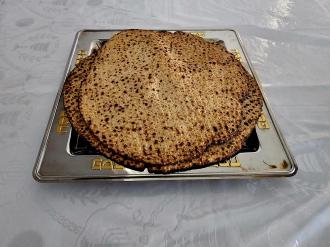From where did the Biblical Philistines originate?
Ancient genomes suggest that the ancestors of the Philistines migrated across the Mediterranean and reached Ashkelon by the early Iron Age
Leon Levy Expedition to Ashkelon director Daniel M. Master:
“For the first time, thanks to state-of-the-art DNA testing on ancient bones, we are able to demonstrate that the Philistines were immigrants to the region of Philistia in the 12th century BC. For thirty years, we excavated at Ashkelon, uncovering Canaanites, early Philistines and later Philistines, and now we can begin to understand the story that these bones tell.”
July 3, 2019 – An international team from the Max Planck Institute for the Science of Human History and the Leon Levy Expedition Ashkelon announces today in Science Advances the findings of a study to determine the provenance of the Philistines, utilizing state-of-the-art technologies on ancient bone samples unearthed during a three-decade excavation in Ashkelon. Analysing genome-wide data retrieved, for the first time, from people who lived in Ashkelon during the Bronze and Iron Age (~3,600-2,800 years ago), the team found that a substantial proportion of their ancestry was derived from a European population. This European-derived ancestry was introduced in Ashkelon around the time of the Philistines’ estimated arrival in the twelfth century BC.
“This genetic distinction is due to European-related gene flow introduced in Ashkelon during either the end of the Bronze Age or the beginning of the Iron Age. This timing is in accord with estimates of the Philistines’ arrival to the coast of the Levant, based on archaeological and textual records,” explains Michal Feldman of the Max Planck Institute for the Science of Human History, leading author of the study.
According to Daniel M. Master, director of the Leon Levy Expedition to Ashkelon and head of the archaeological team, the new genetic input from the direction of Southern Europe was found in bone samples taken from infants buried under the floors of their homes, as was the custom in the 12th century BC. “These infants were not travellers, they are the result of immigration and family building, thereby indicating that their parents did indeed come to the region from overseas in the 12th century BC.” These genetic results, published in Science Advances, are a critical step toward understanding the long-disputed origins of the Philistines.
Master notes that all the Ashkelon samples used in the research (from the Middle Bronze Age, the early Philistines, and the later Philistines found in the Philistine Cemetery) were excavated by teams of professionals who looked at every aspect of their context. “Not only do we have radio-carbon dating that demonstrates the antiquity of the samples, but we also have stratigraphic evidence. These samples come from carefully-excavated contexts, connected to artefacts that can be precisely dated.”
The Philistines are famous for their appearance in the Hebrew Bible as the arch-enemies of the Israelites. However, the ancient texts tell little about Philistine origins other than a later memory that the Philistines came from “Caphtor” (a Bronze Age name for Crete; Amos 9:7). More than a century ago, Egyptologists proposed that a group called the Peleset in texts of the late twelfth century BCE were the same as the Biblical Philistines. The Egyptians claimed that the Peleset travelled from the “the islands,” attacking what is today Cyprus and the Turkish and Syrian coasts, finally attempting to invade Egypt. These hieroglyphic inscriptions were the first indication that the search for the origins of the Philistines should be focused in the late second millennium BCE.
From 1985-2016, the Leon Levy Expedition to Ashkelon, a project of the Harvard Semitic Museum and under license from the Israel Antiquities Authority, took up the search for the origin of the Philistines at Ashkelon, one of the five “Philistine” cities according to the Hebrew Bible. The excavations culminated in the discovery (2013-2016) of the first Philistine cemetery ever to be found. Led by its founder, the late Lawrence E. Stager, and then by Daniel M. Master, the team found substantial changes in ways of life during the 12th century BCE which they connected to the arrival of the Philistines. Many scholars, however, argued that these cultural changes were merely the result of trade or a local imitation of foreign styles and not the result of a substantial movement of people.
This new study represents the culmination of more than thirty years of archaeological work and of genetic research utilizing state of the art technologies, concluding that the advent of the Philistines in the southern Levant involved a movement of people from the west during the Bronze to Iron Age transition.
Genetic discontinuity between the Bronze and Iron Age people of Ashkelon
The researchers successfully recovered genomic data from the remains of ten individuals who lived in Ashkelon during the Bronze and Iron Age. This data allowed the team to compare the DNA of the Bronze and Iron Age people of Ashkelon to determine how they were related. Each individual produced tens of thousands of data points, allowing for powerful statistical comparisons with other populations. The researchers found that individuals across all time periods derived most of their ancestry from the local Levantine gene pool, but that individuals who lived in early Iron Age Ashkelon had a European-derived ancestral component that was not present in their Bronze Age predecessors.
This suggests that ancestors of the Philistines migrated across the Mediterranean, reaching Ashkelon by the early Iron Age, but this European-related genetic component was subsequently diluted by the local Levantine gene pool over the succeeding centuries, suggesting intensive admixture between local and foreign populations. Interestingly, while there was a change in the Philistines’ genetic profile over time, there was continuity in their ethnicity.
“DNA can be a powerful tool to record history and answer historical questions”, notes archaeogeneticist Michal Feldman. “On the other hand, it reminds us that culture or ethnicity do not necessarily equal the genetic make-up of the same groups.” Daniel Master concurs: “Over time, we can show that Philistine culture changed, that their language changed, and now that their genetic profile changed, but, according to their neighbours, they remained Philistines from beginning to end.”

















